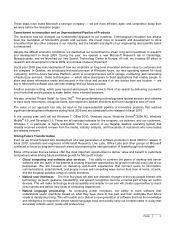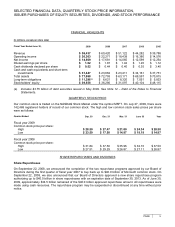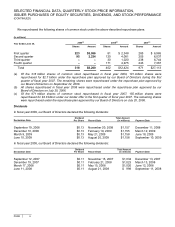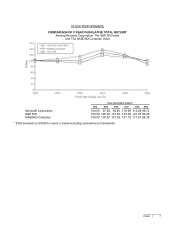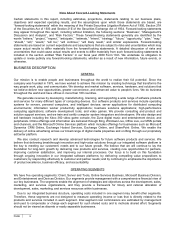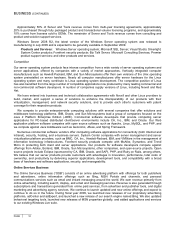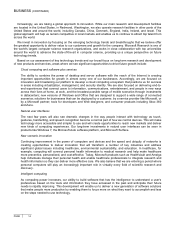Microsoft 2009 Annual Report Download - page 13
Download and view the complete annual report
Please find page 13 of the 2009 Microsoft annual report below. You can navigate through the pages in the report by either clicking on the pages listed below, or by using the keyword search tool below to find specific information within the annual report.
PAGE 13
In addition to competing against software published for non-Xbox platforms, our games business also competes
with numerous companies that we have licensed to develop and publish software for the Xbox consoles. Zune
competes with Apple and other manufacturers of digital music and entertainment devices. Our PC hardware
products face aggressive competition from computer and other hardware manufacturers, many of which are also
current or potential partners. Mediaroom faces competition primarily from a variety of competitors that provide
elements of an Internet protocol television delivery platform, but that do not provide end-to-end solutions for the
network operator. Windows Mobile software and services faces substantial competition from Apple, Google, Nokia,
Openwave Systems, Palm, QUALCOMM, Research In Motion, and Symbian. The embedded operating system
business is highly fragmented with many competitive offerings. Key competitors include IBM, Intel, and versions of
embeddable Linux from commercial Linux vendors such as Metrowerks and MontaVista Software.
OPERATIONS
To serve the needs of customers around the world and to improve the quality and usability of products in
international markets, we localize many of our products to reflect local languages and conventions. Localizing a
product may require modifying the user interface, altering dialog boxes, and translating text.
Our operational centers support all operations in their regions, including customer contract and order processing,
credit and collections, information processing, and vendor management and logistics. The regional center in Ireland
supports the European, Middle Eastern, and African region; the center in Singapore supports the Japan, Greater
China and Asia-Pacific region; and the centers in Fargo, North Dakota, Fort Lauderdale, Florida, Puerto Rico,
Redmond, Washington, and Reno, Nevada support Latin America and North America. In addition to the operational
centers, we also operate data centers throughout the United States and in Europe.
We contract most of our manufacturing activities for Xbox 360 and related games, Zune, various retail software
packaged products, and Microsoft hardware to third parties. Our products may include some components that are
available from only one or limited sources. Our Xbox 360 console includes certain key components that are supplied
by a single source. The central processing unit is purchased from IBM and the graphics chips and embedded
dynamic random access memory chips for the graphics processing unit are purchased from Taiwan Semiconductor
Manufacturing Company. Although we have chosen to initially source these key Xbox 360 components from a single
supplier, we are under no obligation to exclusively source components from these vendors in the future. Beyond the
exceptions noted, we generally have the ability to use other custom manufacturers if the current vendor becomes
unavailable. We generally have multiple sources for raw materials, supplies, and components, and are often able to
acquire component parts and materials on a volume discount basis.
RESEARCH AND DEVELOPMENT
During fiscal years 2009, 2008, and 2007, research and development expense was $9.0 billion, $8.2 billion, and $7.1
billion, respectively. These amounts represented 15%, 14%, and 14%, respectively, of revenue in each of those
years. We plan to continue to make significant investments in a broad range of research and product development
efforts.
While most of our software products are developed internally, we also purchase technology, license intellectual
property rights, and oversee third-party development and localization of certain products. We believe we are not
materially dependent upon licenses and other agreements with third parties relating to the development of our
products. Internal development allows us to maintain closer technical control over our products. It also gives us the
freedom to decide which modifications and enhancements are most important and when they should be
implemented. Generally, we also create product documentation internally. We strive to obtain information as early as
possible about changing usage patterns and hardware advances that may affect software design. Before releasing
new software platforms, we provide application vendors with a range of resources and guidelines for development,
training, and testing.
Investing in Business and Product Development
Innovation is the foundation for Microsoft’s success. Our model for growth is based on our ability to initiate and
embrace disruptive technology trends, to enter new markets, both in terms of geographies and product areas, and to
drive broad adoption of the products and services we develop and market. We maintain our long-term commitment
to research and development across a wide spectrum of technologies, tools, and platforms spanning communication
and collaboration; information access and organization; entertainment; business and e-commerce; advertising; and
devices.


